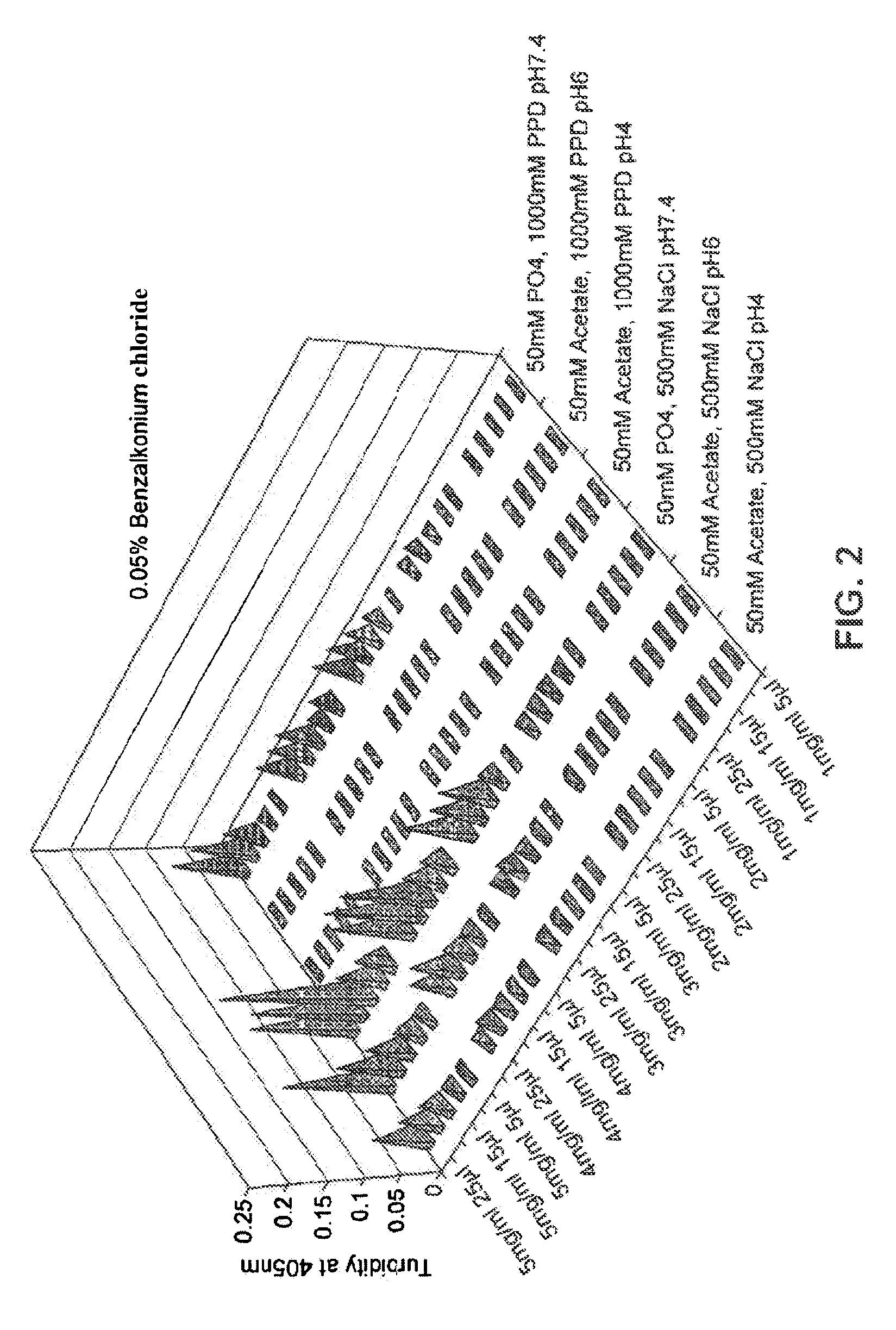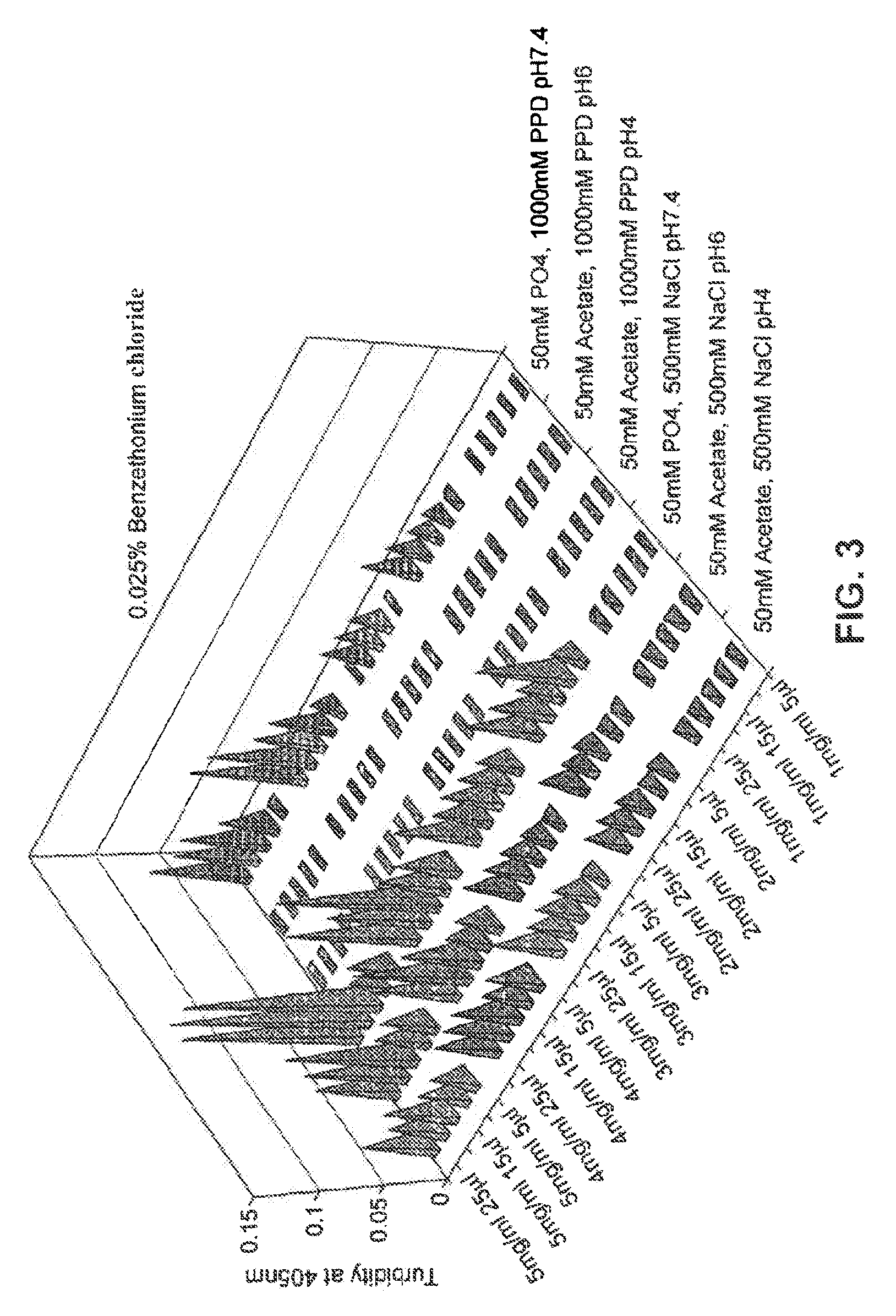Glucagon composition
a technology of glucagon and composition, which is applied in the field of glucagon formulations, can solve the problems of more pain, failed attempts to develop such a formulation,
- Summary
- Abstract
- Description
- Claims
- Application Information
AI Technical Summary
Benefits of technology
Problems solved by technology
Method used
Image
Examples
example 1
Effect of Surfactants on the Solubility of Glucagon
Purpose of the Experiment
[0074]Glucagon is known to be soluble in aqueous solutions at pH9. The solubility between pH 3 to 9 is extremely low. The purpose of this experiment was to assess the effect of various excipients, particularly surfactants, on the solubility of glucagon at pH around 6. The excipients were tested at a selected concentration as indicated and no experiments were carried out at this stage to explore the effect of the concentration of the excipients on the glucagon solubility. The concentration of excipients tested was in excess of that of glucagon.
Experimental Procedure
[0075]Approximately 2 mg of glucagon was weighed out into a glass vial and the solution of excipients was added to give final glucagon concentration of 1 mg / ml. Visual observations were made for up to 1 hour. All experiments except sodium deoxycholate contained 10 mM histidine buffer (pH 6). Sodium deoxycholate was formulated in 10 mM TRIS (pH 7.5)...
example 2
A Matrix Approach to Investigate the Effect of Several Parameters on Glucagon Solubility and Appearance of the Dissolved Glucagon
Purpose of the Experiment
[0088]In this experiment, the combined effect of the following parameters was investigated on the solubility and appearance:[0089]Nature of surfactant (benzethonium salt, benzalkonium salt)[0090]Concentration of surfactant[0091]pH[0092]Concentration of ionic species
Experimental Procedure
[0093]Forty solutions containing a given concentration of glucagon and a given concentration of a cationic surfactant were prepared. All solutions contained 2 mM acetate and were adjusted to pH 5. No additional excipients were present. The concentrations of glucagon and cationic surfactant are shown in the Table below together with the indication of glucagon solubility following incubation for 24 hours:
[0094]
Glucagon concentrationSurfactant1 mg / ml2 mg / ml3 mg / ml4 mg / ml5 mg / mlBenzethonium chlorideDissolvedDissolvedDissolvedDissolvedDissolved(0.05% w / v...
example 3
Further Investigation of the Effect of Surfactants on the Solubility of Glucagon
Purpose of the Experiment
[0126]Glucagon solubility in aqueous solutions between pH 3 to 9 is extremely low. The purpose of this experiment was to assess the effect of the concentration of the surfactants benzethonium chloride and benzalkonium chloride, on the solubility of glucagon at pH 4.5 and pH 5.5, by means of visual assessment upon preparation and after storage. Base formulations were used that included a single buffer (5 mM acetate) and tonicity modifier (250 mM mannitol), at either pH 4.5 or pH 5.5. The surfactant excipients were tested at a range of selected concentrations as indicated.
Experimental Procedure
[0127]Approximately 2 mg of glucagon was weighed out into a glass vial and the solution of excipients in one of the base formulations was added to give final glucagon concentration of 1 mg / ml. The concentration of surfactant used ranged from 0.01% to 0.6% w / v specifically 0.01, 0.025, 0.05, 0...
PUM
| Property | Measurement | Unit |
|---|---|---|
| pH | aaaaa | aaaaa |
| pH | aaaaa | aaaaa |
| concentration | aaaaa | aaaaa |
Abstract
Description
Claims
Application Information
 Login to View More
Login to View More - R&D
- Intellectual Property
- Life Sciences
- Materials
- Tech Scout
- Unparalleled Data Quality
- Higher Quality Content
- 60% Fewer Hallucinations
Browse by: Latest US Patents, China's latest patents, Technical Efficacy Thesaurus, Application Domain, Technology Topic, Popular Technical Reports.
© 2025 PatSnap. All rights reserved.Legal|Privacy policy|Modern Slavery Act Transparency Statement|Sitemap|About US| Contact US: help@patsnap.com



